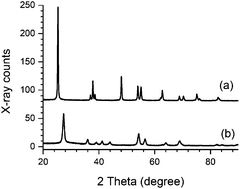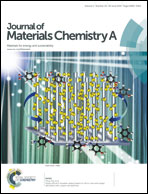Rutile TiO2-based perovskite solar cells†
Abstract
A perovskite solar cell based on rutile TiO2 film was prepared and its photovoltaic performance was compared to an anatase TiO2-based perovskite solar cell. Rutile TiO2 nanoparticles with aspect ratio of 0.2 (20 nm wide and 100 nm long) were prepared by hydrolysis of TiCl4 at ambient temperature. Anatase TiO2 nanoparticles with diameter of about 50 nm were hydrothermally synthesized. The annealed rutile film showed porosity of 60.6%, while lower porosity of 49.1% was detected in the anatase TiO2 film. CH3NH3PbI3 perovskite was deposited on TiO2 film using either a one-step spin coating or two-step dipping method. 2,2′,7,7′-Tetrakis(N,N-p-dimethoxy-phenylamino)-9,9′-spirobifluorene (spiro-MeOTAD) was used as a hole transporting material. One-step deposition led to average power conversion efficiency (PCE) of 8.19% from the rutile-perovskite solar cells and 7.23% from the anatase-perovskite solar cells, while two-step deposition resulted in higher average PCE of 13.75% for the former device and 13.99% for the latter one. Regardless of the deposition methodologies, the rutile–perovskite solar cell showed generally higher Jsc and lower Voc. Slower electron transport and longer electron lifetime were observed for the rutile-based perovskite solar cell than for the anatase-based one. Although the same perovskite material was used for both rutile and anatase TiO2, the difference in electronic behavior indicates that photo-excited electrons are in part injected to TiO2 and the extent of electron injection can be influenced by the crystal phase of TiO2. Despite longer electron lifetime, the slightly lower voltage of the rutile-based device might be due to the fact that the amount of injected electrons was relatively larger for rutile than anatase, leading to a lower Fermi energy level at equilibrium between TiO2 and perovskite. Using a 260 nm-thick rutile TiO2 film, the highest PCE of 14.46% was achieved by depositing CH3NH3PbI3 using a two-step method, in which photocurrent density of 20.02 mA cm−2, open-circuit voltage of 1.022 V and fill factor of 0.71 were demonstrated.


 Please wait while we load your content...
Please wait while we load your content...